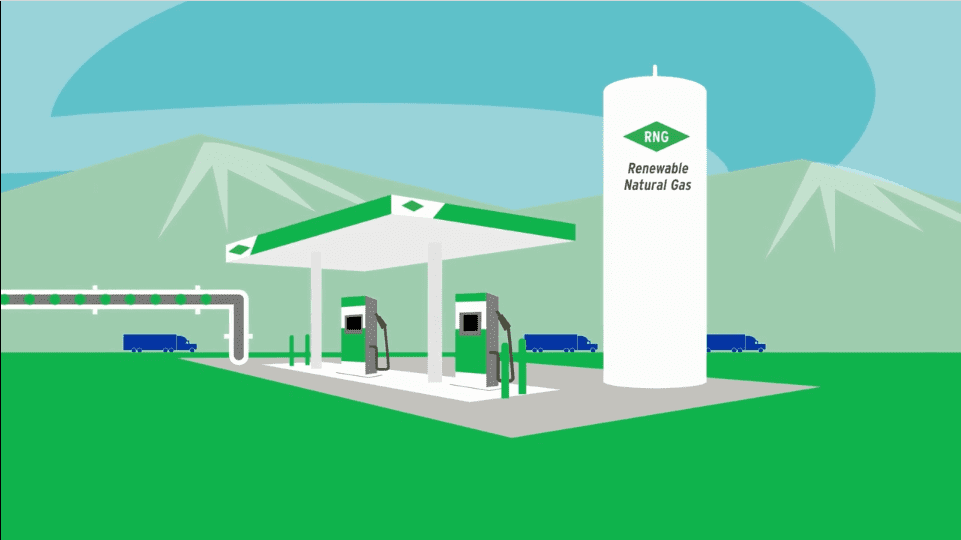Is natural gas renewable? What is renewable natural gas? Is renewable natural gas a fossil fuel?
To those of us in the industry, these questions may sound like no-brainers. However, I have found myself at events or in casual conversation where these questions are being asked. In fact, according to Google search data, these questions are asked thousands of times on average every month.
So, to put it simply, renewable natural gas (RNG) is not a fossil fuel. RNG never spent millions of years underground. Instead, RNG is an ultra-clean and ultra-low-carbon natural gas alternative made from the methane that is captured when organic waste from food scraps, animal manure and sewage is broken down, captured and refined.
Chemically, RNG is almost identical to geologic, or fossil, natural gas. Coal, crude oil and natural gas are all considered fossil fuels because they were formed from the buried remains of animals and plants that lived millions of years ago. RNG comes from the management of common, everyday waste like landfills, dairies, wastewater treatment and many other sources. No drilling required.
RNG, also known as biomethane, is pipeline quality gas that is fully interchangeable with geologic natural gas for generating electricity, heating homes, cooking, and, arguably the most important use, as a transportation fuel. It can play a key role in the medium- and heavy-duty transportation sectors by generating immediate air quality benefits.
RNG is an ultra-clean and ultra-low-carbon natural gas alternative made from the methane that is captured when organic waste from food scraps, animal manure and sewage is broken down, captured and refined.
RNG has the lowest carbon intensity rating of key transportation fuels when comparing the well-to-wheels greenhouse gas (GHGs) emissions of various fuels in heavy-duty trucking applications. Based on the California Air Resources Board’s carbon intensities, RNG can reduce GHG emissions by 40 to 125% or more, depending on the renewable feedstock used to produce it.
Various government, industry and academia studies have found that America has sufficient existing recoverable feedstock to produce from 35 to 70 billion diesel gallon equivalents (DGE) of RNG per year. Here in California, multiple reputable sources have found that sufficiently large volumes of RNG can be produced today to displace the state’s on-road heavy-duty truck diesel usage.
In California, nearly all of the natural gas transportation fuel comes from renewable sources, allowing California to sustainably manage its vast volumes of waste products and mitigate short-lived climate pollutants, as well as provide new opportunities for economic and job growth.
Why RNG is Important for California
California is home to 8 of the top 10 most polluted cities in the United States, where air quality fails to meet the federally mandated standards for healthy air. Asthma, heart disease and respiratory illness are just a few of the negative impacts of living with unhealthy air.
Our economy depends on the trucking industry, but our health depends on clean air. Fortunately, we can achieve clean air quickly and affordably with the use of near-zero emission natural gas medium- and heavy-duty vehicles.
As a whole, more than 90% of Californians live with unhealthy air. The leading source of urban air pollution is the 3.5 million diesel semi-trucks that transport 70% of all manufactured and retail goods throughout California each day.
Our economy depends on the trucking industry, but our health depends on clean air. Fortunately, we can achieve clean air quickly and affordably with the use of near-zero emission natural gas medium- and heavy-duty vehicles. These vehicles are available for purchase today and are the most efficient, cost-effective pathway to mitigate public health risks caused by harmful emissions from high-polluting diesel trucks.
These trucks can yield air quality benefits in areas that are overburdened by diesel pollution and have been proven to run 90% cleaner than today’s cleanest diesel trucks. In fact, they have emissions comparable to electric trucks.
Today’s natural gas trucks offer an affordable path to replace diesel trucks at the scale needed to restore healthy air. These trucks are already being used reliably by companies and fleets across the nation.
So, when people ask, is natural gas renewable, the answer is that it can be and that renewable natural gas is incredibly important for our climate protection and air quality goals.
In California, the good news is most of the natural gas used as a transportation fuel is RNG, produced from capturing methane gas from existing organic sources. Capturing these methane sources is critical for climate protection.
As our cities quickly approach looming deadlines for federally mandated standards for healthy air, join us in telling your local and state leaders that you support prioritized funding for trucks fueled by RNG. Let’s work together to achieve clean air today.
So, when people ask, is natural gas renewable, the answer is that it can be and that renewable natural gas is incredibly important for our climate protection and air quality goals.
Learn more at www.CNGVP.org and www.NGVGameChanger.com


